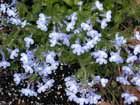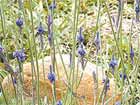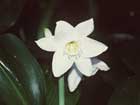Plant Profiles
Click on the first letter of the common name of the plant you wish more information about.
A | B | C | D | E | F | G | H | I | J | K | L | M | N | O | P | Q | R | S | T | U | V | W | X | Y | Z
E

Edging Lobelia
Scientific Name: Lobelia erinus
Growth Habit: A rounded to trailing annual growing to 12 inches tall and wide. Plants produce multiple stems with bright-green, oval, large-toothed leaves growing to 2 inches long and half as wide.
Light: Plant in full sun to light shade.
Feedings: Lightly apply a general garden fertilizer monthly.
Water Needs: Tolerates short periods of drought; grows best with weekly waterings.
Ease of Culture: Easy.
Propagation: Start plants from seed.
Hardiness: Hardy.
Major Problems: Plant in well-drained soils to avoid root-rot problems. Expect plants to decline during the hot, humid weather.
Pruning: Remove shoots that grow out of bounds or encroach upon nearby flowers, as needed. Declining flower stems also can be removed to encourage additional shoots with blooms.
Uses: An attractive annual for the cooler months to plant in clusters as part of flower gardens or to use as a temporary border along walkways. Plantings are blanketed with bright-blue multipetaled blossoms with a white eye held well above the foliage. They bloom January through May, then decline during the hot, humid months. Plants also can be used in hanging baskets or added to containers with other seasonal flowers.
Florida Native: No: native to South Africa.

English Lavender
Scientific Name: Lavandula angustifolia
Growth Habit: An upright to rounded perennial growing to 18 inches tall and wide when in bloom. The leaves are narrow and simple to oval and lacelike, depending on the variety. All leaves are gray-green in color and grow to 2 inches long and an inch wide.
Light: Plant in full sun to light shade.
Feedings: Apply a light feeding with a general garden fertilizer every six to eight weeks during periods of growth.
Water Needs: Tolerates short periods of drought; grows best with weekly waterings.
Ease of Culture: Medium; subject to summer-rot problems.
Propagation: Start plants from cuttings.
Hardiness: Hardy.
Major Problems: English lavender grows well during the cooler months but is subject to rot problems during the hot, humid summer weather. Plant in a well-drained soil or a container to delay decline.
Pruning: Remove declining flowering stems as needed. Also thin out some of the older shoots after flowering to encourage vigorous growths.
Uses: An attractive, short-lived perennial for gardens best planted in clusters to provide an attractive display of lavender spikes of blossoms held well above the foliage. Plants also can be grown in containers alone or mixed with other flowers to display on the patio or along walkways. Flowers can be cut to use in fresh bouquets or dried for future arrangements.
Florida Native: No; native to the Western Mediterranean region.

Eucharist Lily
Scientific Name: Eucharis amazonica
Growth Habit: A bulbous perennial with large evergreen leaves arising from near the ground, producing foot-tall plants. The leaves are oval with prominent veins growing to 6 inches wide.
Light: Plant in a shady location; damaged by sun.
Feedings: Apply a light scattering of a general garden fertilizer every other month March through September. Feed container plants monthly with a 20-20-20 or similar fertilizer March through November.
Water Needs: Tolerates short periods of drought; grows best in a moist soil with weekly waterings during the warmer months. Allow surface soil to dry between waterings during the cooler months to encourage flowering.
Ease of Culture: Easy.
Propagation: Start plants by dividing older clusters of bulbs.
Hardiness: Hardy; foliage may be damaged by severe freezes, but plants grow back from bulbs below the soil surface.
Major Problems: Slugs feed heavily on the foliage during warm, moist growing conditions. Handpick or apply slug baits as a control. Caterpillars and mites may also need periodic control using natural pesticides.
Pruning: Remove declining and slug-damaged leaves plus old flower stalks as needed to keep attractive beds. After severe winters, plants also may need a spring grooming to remove the damaged foliage.
Uses: An attractive ground cover and accent plant for the shady areas of the landscape. Eucharist lilies, also called Amazon lilies, resemble the large green-leaf hostas gardeners admire from Northern gardens. The lilies sprout up to 2-foot-tall stalks topped with fragrant white narcissuslike blooms January through March. They bloom sporadically during the remaining warmer months. The plants also can be grown in containers for the patio and indoors.
Florida Native: No; native to Colombia and Peru.